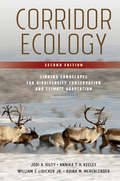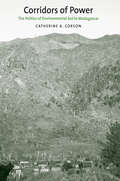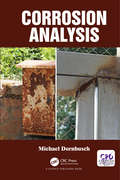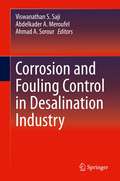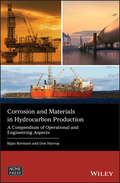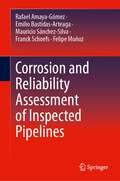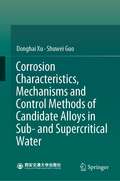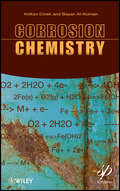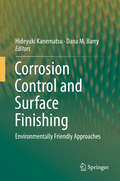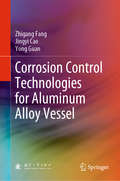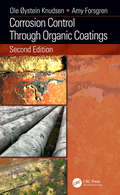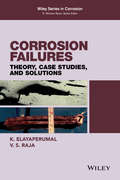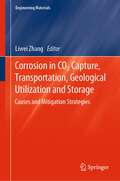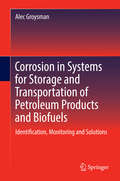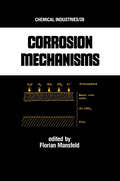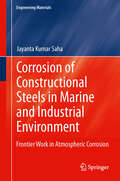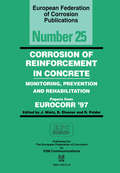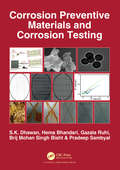- Table View
- List View
The Correspondence Of Charles Darwin: Volume 20 1872
by Frederick Burkhardt James A. Secord Janet Browne Samantha Evans Shelley Innes Francis Neary Alison M. Pearn Anne Secord Paul WhiteThis volume is part of the definitive edition of letters written by and to Charles Darwin, the most celebrated naturalist of the nineteenth century. Notes and appendixes put these fascinating and wide-ranging letters in context, making the letters accessible to both scholars and general readers. Darwin depended on correspondence to collect data from all over the world, and to discuss his emerging ideas with scientific colleagues, many of whom he never met in person. The letters are published chronologically: volume 20 includes letters from 1872, the year in which The expression of the emotions in man and animals was published, making ground-breaking use of photography. Also in this year, the sixth and final edition of On the origin of species was published, and Darwin resumed his work on carnivorous plants and plant movement, finding unexpected similarities between the plant and animal kingdoms.
The Correspondence of Charles Darwin: Volume 26, 1878 (The Correspondence of Charles Darwin)
by Charles Darwin Frederick Burkhardt James A. Secord The Editors of the Darwin Correspondence ProjectThis volume is part of the definitive edition of letters written by and to Charles Darwin, the most celebrated naturalist of the nineteenth century. Notes and appendixes put these fascinating and wide-ranging letters in context, making the letters accessible to both scholars and general readers. Darwin depended on correspondence to collect data from all over the world, and to discuss his emerging ideas with scientific colleagues, many of whom he never met in person. The letters are published chronologically: volume 26 includes letters from 1878, the year in which Darwin with his son Francis carried out experiments on plant movement and bloom on plants. Francis spent the summer at a botanical research institute in Germany; and father and son exchanged many detailed letters about his work. Meanwhile, Darwin tried to secure government support for attempts by one of his Irish correspondents to breed a blight-resistant potato.
The Correspondence of Charles Darwin 1877: VOLUME 25 (The Correspondence of Charles Darwin)
by Frederick Burkhardt James A. SecordThis volume is part of the definitive edition of letters written by and to Charles Darwin, the most celebrated naturalist of the nineteenth century. Notes and appendixes put these fascinating and wide-ranging letters in context, making the letters accessible to both scholars and general readers. Darwin depended on correspondence to collect data from all over the world, and to discuss his emerging ideas with scientific colleagues, many of whom he never met in person. The letters are published chronologically: volume 25 includes letters from 1877, the year in which Darwin published Forms of Flowers and with his son Francis carried out experiments on plant movement and bloom on plants. Darwin was awarded an honorary LL. D. by Cambridge University, and appeared in person to receive it. The volume contains a number of appendixes, including two on the albums of photograph sent to Darwin by his Dutch, German, and Austrian admirers.
The Correspondence of Charles Darwin: Volume 27, 1879 (The Correspondence of Charles Darwin)
by Charles DarwinThis volume is part of the definitive edition of letters written by and to Charles Darwin, the most celebrated naturalist of the nineteenth century. Notes and appendixes put these fascinating and wide-ranging letters in context, making the letters accessible to both scholars and general readers. Darwin depended on correspondence to collect data from all over the world, and to discuss his emerging ideas with scientific colleagues, many of whom he never met in person. The letters are published chronologically: volume 27 includes letters from 1879, the year in which Darwin completed his manuscript on movement in plants. He also researched and published a biography of his grandfather Erasmus. The Darwins spent most of August on holiday in the Lake District. In October, Darwin's youngest son, Horace, became officially engaged to Ida Farrer, after some initial resistance from her father, who, although an admirer of Charles Darwin, thought Horace a poor prospect for his daughter.
The Correspondence of Charles Darwin: Volume 28, 1880 (The Correspondence of Charles Darwin)
by Charles Darwin The Editors of the Darwin Correspondence ProjectThis volume is part of the definitive edition of letters written by and to Charles Darwin, the most celebrated naturalist of the nineteenth century. Notes and appendixes put these fascinating and wide-ranging letters in context, making the letters accessible to both scholars and general readers. Darwin depended on correspondence to collect data from all over the world, and to discuss his emerging ideas with scientific colleagues, many of whom he never met in person. The letters are published chronologically. In 1880, Darwin published On The Power of Movement in Plants, and began writing his final book, The Formation of Vegetable Mould through the Action of Worms. He was engaged in controversy with Samuel Butler, following publication of his last book, Erasmus Darwin. At the end of the year, he succeeded in raising support for a Civil List pension for Alfred Russel Wallace, co-discoverer of the theory of natural selection.
The Correspondence of Charles Darwin: Volume 29, 1881 (The Correspondence of Charles Darwin)
by Charles DarwinThis volume is part of the definitive edition of letters written by and to Charles Darwin, the most celebrated naturalist of the nineteenth century. Notes and appendixes put these fascinating and wide-ranging letters in context, making the letters accessible to both scholars and general readers. Darwin depended on correspondence to collect data from all over the world, and to discuss his emerging ideas with scientific colleagues, many of whom he never met in person. The letters are published chronologically. In 1881, Darwin published his final book, The Formation of Vegetable Mould through the Action of Worms. He reflected on reactions to his previous book, The Power of Movement in Plants, and worked on two papers for the Linnean Society on the action of carbonate of ammonia on plants. In this year, Darwin's elder brother, Erasmus, died, and a second grandchild, also named Erasmus, was born.
The Correspondence of Charles Darwin: Volume 30, 1882 (The Correspondence of Charles Darwin)
by Charles DarwinThis volume is part of the definitive edition of letters written by and to Charles Darwin, the most celebrated naturalist of the nineteenth century. Notes and appendixes put these fascinating and wide-ranging letters in context, making the letters accessible to both scholars and general readers. Darwin depended on correspondence to collect data from all over the world, and to discuss his emerging ideas with scientific colleagues, many of whom he never met in person. The letters are published chronologically. Darwin died in April 1882, but was active in science almost up until the end, raising new research questions and responding to letters about his last book, on earthworms. The volume also contains a supplement of nearly 400 letters written between 1831 and 1880, many of which have never been published before.
Corridor Ecology, Second Edition: Linking Landscapes for Biodiversity Conservation and Climate Adaptation
by Jodi A. Hilty Annika T.H. Keeley William Z. Lidicker Jr. Adina M. MerenlenderMigrating wildlife species across the globe face a dire predicament as their traditional migratory routes are cut off by human encroachment. Forced into smaller and smaller patches of habitat, they must compete more aggressively for dwindling food resources and territory. This is more than just an unfortunate side effect of human progress. As key species populations dwindle, ecosystems are losing resilience and face collapse, and along with them, the ecosystem services we depend on. Healthy ecosystems need healthy wildlife populations. One possible answer? Wildlife corridors that connect fragmented landscapes.This new and expanded second edition of Corridor Ecology: Linking Landscapes for Biodiversity Conservation and Climate Adaptation captures the many advances in the field over the past ten years. It builds on concepts presented in the first edition on the importance and practical details of maintaining and restoring land connectivity. New to this edition is a guest-edited chapter on ecological connectivity in oceans, including a detailed discussion on pelagic marine corridors and how coastal corridors can provide critical connectivity between marine protected areas. Another new chapter considers the effects of climate change on habitat and offers recommendations on designing effective corridors as landscapes change with shifting climate conditions. The book also includes a discussion of corridors in the air for migrating flying species, from birds to bats, butterflies, and even plant propagules—a concept so new that a term to describe it has yet to be coined. All chapters are thoroughly revised and updated.Practitioners as well as serious scholars of landscape ecology and the science of protecting biodiversity will find this new edition of corridor ecology science an indispensable resource.
Corridors of Power: The Politics of Environmental Aid to Madagascar
by Catherine A. CorsonA highly regarded academic and former policy analyst and consultant charts the forty-year history of neoliberalism, environmental governance, and resource rights in Madagascar Since the 1970s, the U. S. Agency for International Development has spent millions of dollars to preserve Madagascar's rich biological diversity. Yet its habitats are still in decline. Studying forty years of policy making in multiple sites, Catherine Corson reveals how blaming impoverished Malagasy farmers for Madagascar's environmental decline has avoided challenging other drivers of deforestation, such as the logging and mining industries. In this important ethnographic study, Corson reveals how Madagascar's environmental program reflects the transformation of global environmental governance under neoliberalism.
Corrosion Analysis
by Michael DornbuschThe book gives an overview about all relevant electrochemical and spectroscopic methods used in corrosion research. Besides the correct use and interpretation, the methods are correlated with industrial test methods for organic coatings and conversion layers.
Corrosion and Fouling Control in Desalination Industry
by Viswanathan S. Saji Abdelkader A. Meroufel Ahmad A. SorourThis book addresses two critical problems that plague materials that make up components in both desalination and cooling water systems: corrosion, and fouling. The book addresses various types and components of industrial desalination technologies with solutions for controlling corrosion, scaling and biofouling. Issues unique to desalination systems, vital for the production of clean water, are considered as well. Green technologies are discussed throughout, along with environmental and economic considerations. The book presents solutions to the problems encountered by internal and external parts of these systems and will aid professionals that design, operate, and maintain them. It will be valuable to professionals in the materials, corrosion, electrochemical and wastewater industries, as well as chemical engineers.Addresses the corrosion issues facing the conventional and modern water desalination systems;Discusses the causes and remediation of problems caused by corrosion, scaling, and biofouling in water treatment;Offers green solutions, thereby minimizing environmental impact while increasing control and productivity of water systems;Suitable for professionals working with water desalination plants, materials scientists and corrosion engineers.
Corrosion and Materials in Hydrocarbon Production: A Compendium of Operational and Engineering Aspects (Wiley-ASME Press Series)
by Dr. Bijan Kermani Don HarropComprehensively covers the engineering aspects of corrosion and materials in hydrocarbon production This book captures the current understanding of corrosion processes in upstream operations and provides a brief overview of parameters and measures needed for optimum design of facilities. It focuses on internal corrosion occurring in hydrocarbon production environments and the key issues affecting its occurrence, including: the types and morphology of corrosion damage; principal metallic materials deployed; and mitigating measures to optimise its occurrence. The book also highlights important areas of progress and challenges, and looks toward the future of research and development to enable improved and economical design of facilities for oil and a gas production. Written for both those familiar and unfamiliar with the subject—and by two authors with more than 60 years combined industry experience—this book covers everything from Corrosion Resistant Alloys (CRAs) to internal metal loss corrosion threats, corrosion in injection systems to microbiologically influenced corrosion, corrosion risk analysis to corrosion and integrity management, and more, notably: Comprehensively covers the engineering aspects of corrosion and materials in hydrocarbon production Written by two, renowned experts in the field Offers practical guide to those unfamiliar with the subject whilst providing a focused roadmap to addressing the topics in a precise and methodical manner Covers all aspects of corrosion threat and remedial and mitigation measures in upstream hydrocarbon production applicable to sub-surface, surface, and transportation facilities Outlines technology challenges that need further research as a pre-cursor to moving the industry forward. Operational and Engineering Aspects of Corrosion and Materials in Hydrocarbon Production is an excellent guide for both practicing materials and corrosion engineers working in hydrocarbons production as well as those entering the area who may not be fully familiar with the subject.
Corrosion and Reliability Assessment of Inspected Pipelines
by Rafael Amaya-Gómez Emilio Bastidas-Arteaga Mauricio Sánchez-Silva Franck Schoefs Felipe MuñozThis book provides the most up-to-date, advanced methods and tools for risk assessment of onshore pipelines. These methods and tools are based primarily on information collected from ILI measurements and additional information about the soil surrounding the pipeline. The book provides a better understanding how the defects grow and interact (repulsion or attraction) and their spatial variability. In addition, the authors contemplate new defects that evolve between inspections and how they could affect the pipeline's reliability. A real-world case is presented to reinforce the concepts presented in the book. The book is structured into three parts: i) an introduction to onshore pipelines and the problem of corrosion, ii) a framework that deals with uncertainty for integrity programs for corroded pipelines, and iii) the applications of the methods presented in the book. The book is ideal for researchers and field engineers in oil and gas transportation and graduate and undergraduate engineering students interested in pipeline reliability assessments, spatial variability, and risk-based inspections.
Corrosion Characteristics, Mechanisms and Control Methods of Candidate Alloys in Sub- and Supercritical Water
by Donghai Xu Shuwei GuoThis book aims to provide comprehensive and systematic introduction and summary of corrosion characteristics, mechanisms, and control methods of candidate alloys in sub- and supercritical water environment. First of all, corrosion types of candidate alloys and the effects of major alloying elements on corrosion resistance of potential alloys in sub- and supercritical water are compared and analyzed. At the same time, research status of candidate materials, and development and application trends of several corrosion-resistant alloys are summarized. Then, corrosion characteristics of Ni-Cr, Ni-Cr-Mo, Ni-Fe-Cr and Ni-Fe-Cr-Mo-Cu corrosion-resistant alloys, FeCrAl alloy, and Zircaloy are discussed in detail, including the corrosion rate, the structure and composition of oxide film, and the effects of various surface treatment processes, etc. More specifically, it also investigates corrosion behavior of Ni-based alloy, Fe-Ni-based, and stainless steels in supercritical water. The effects of aggressive species on the corrosion behavior of Ni-base alloys are also explored in supercritical water. Readers will further discover the total corrosion processes and mechanisms of typical candidate alloys in sub- and supercritical water environment. Finally, the work explores the corrosion control methods such as ceramic coatings and passivation processes in supercritical water oxidation and in subcritical water, respectively. Future challenges and development trends of corrosion research of candidate materials in sub- and supercritical water environments are covered at the end of this book. It offers valuable reference for theoretically guiding material selection and design and operating parameter optimization of key equipment in the sub- and supercritical water technologies. The book is written for senior undergraduates, graduate students, scholars, and researchers who are interested in corrosion behavior of candidate materials of supercritical water oxidation system, supercritical water gasification system, and nuclear reactor.
Corrosion Chemistry
by Volkan Cicek Bayan Al-NumanCorrosion Chemistry details the scientific background of the corrosion process and contemporary applications for dealing with corrosion for engineers and scientists, covering the most recent breakthroughs and trends. Corrosion is in essence a chemical process, and it is crucial to understand the dynamics from a chemical perspective before proceeding with analyses, designs and solutions from an engineering aspect. This book can be used both as a textbook and a reference book both by academics and engineers and scientists in the field. As a reference for the engineer in the field, it is both a refresher for the veteran on the causes of corrosion and the methods, processes, and technologies to deal with it, over a variety of industries. It is the most up-to-date, comprehensive treatment of corrosion available, covering the most cutting-edge new processes and theories. For the freshman engineer just entering the field, it is a tremendous introduction to corrosion. As a textbook, it can be used for a single semester technical elective course in undergraduate and postgraduate education for disciplines such as chemistry, chemical engineering, petroleum engineering, civil engineering, material engineering, mechanical engineering, metallurgical engineering, mining engineering, agricultural engineering, and other related technical fields.
Corrosion Control and Surface Finishing: Environmentally Friendly Approaches
by Hideyuki Kanematsu Dana M. BarryThis book deals with the surface finishing for corrosion prevention fromthe viewpoint of environmental friendliness. Surface finishing for metallic materialsor by metallic materials has excellent corrosion resistance, wear resistance andgood color tones, which have been useful for practical applications so far. However,environmental friendliness and user friendliness have become important factors forpractical use since the turn of the century. Surface Finishing Industries are nowfacing a serious crossroad to continue sustainable developments in the future. Sadly,the concept of environmental friendliness is very new, because from the beginningof this discipline (surface finishing), not many people considered the environmentaleffects so seriously, but sought mainly for the functions, performance, characteristics,and economic profits. Since the biological evaluation processes are very advancedand still debated, this book is very unique and advanced. This book aims to letuniversity students know and learn the concept of environmental friendliness andits relation to surface treatment products based on the fundamental knowledge aboutconventional corrosion control and surface finishing. The textbook will be usedmost effectively with subjects such as surface science, surface engineering, mechanicalmaterials, etc. for those studying mechanical engineering, materials engineeringand chemical engineering. It is also applicable to practical engineers and researchersin the industrial world as well as the academic one. Throughout this book, readerslearn and appreciate the environmentally friendly approaches that are presentedfor corrosion control and surface finishing.
Corrosion Control Technologies for Aluminum Alloy Vessel
by Zhigang Fang Jingyi Cao Yong GuanThis book elaborates the corrosion testing and assessment methods for the aluminum alloy vessel in the service and internal environment. The emphasis is placed on the research of general materials corrosion characteristics, electrochemical protection design, surface protection, coating and painting, etc. This book helps readers to keep abreast of the whole technology system of the corrosion prevention and control of aluminum alloy vessel, especially the systematic engineering view of life cycle corrosion control for the vessel is of particular interest to readers.
Corrosion Control Through Organic Coatings (Corrosion Technology)
by Ole Øystein Knudsen Amy ForsgrenCorrosion Control Through Organic Coatings, Second Edition provides readers with useful knowledge of the practical aspects of corrosion protection with organic coatings and links this to ongoing research and development. Thoroughly updated and reorganized to reflect the latest advances, this new edition expands its coverage with new chapters on coating degradation, protective properties, coatings for submerged service, powder coatings, and chemical pretreatment. Maintaining its authoritative treatment of the subject, the book reviews such topics as corrosion-protective pigments, waterborne coatings, weathering, aging, and degradation of paint, and environmental impact of commonly used techniques including dry- and wet-abrasive blasting and hydrojetting. It also discusses theory and practice of accelerated testing of coatings to assist readers in developing more accurate tests and determine corrosion protection performance.
Corrosion Failures
by K. Elayaperumal V. S. RajaProvides corrosion basics in a lucid manner to students and working professionals and over 80 corrosion-failure analysis case studies Correlates Failure Analysis with Corrosion Science Exclusively provides corrosion-related failure analysis case histories in one place in a convenient format One-stop shop for both science and real time occurrence of the phenomenon of corrosion Full coverage of all MOC, Materials of Construction, used for process equipments Simple but Lucid presentation of Failure Analysis procedure
Corrosion in CO2 Capture, Transportation, Geological Utilization and Storage: Causes and Mitigation Strategies (Engineering Materials)
by Liwei ZhangThis book systematically discusses the operational stages with high risk of CO2-induced corrosion in CCUS projects, and related measures for corrosion control. CO2 capture, utilization, and storage (CCUS) is a key technology to mitigate climate change and substantially reduce greenhouse gas emissions from fossil fuels. CCUS deals with high concentration CO2, which is very corrosive in a humid environment. Therefore, it is very important to characterize, monitor, and mitigate CO2-induced corrosion in all processes of the CCUS operation chain. Some corrosion control techniques included in this book (e.g., CO2-resisting wellbore cement additives) are beneficial for corrosion control research and engineering practices. This book belongs to the field of corrosion science and engineering, and the expected readership is researchers and engineers working on CCUS.
Corrosion in Systems for Storage and Transportation of Petroleum Products and Biofuels: Identification, Monitoring and Solutions
by Alec GroysmanThis book treats corrosion as it occurs and affects processes in real-world situations, and thus points the way to practical solutions. Topics described include the conditions in which petroleum products are corrosive to metals; corrosion mechanisms of petroleum products; which parts of storage tanks containing crude oils and petroleum products undergo corrosion; dependence of corrosion in tanks on type of petroleum products; aggressiveness of petroleum products to polymeric material; how microorganisms take part in corrosion of tanks and pipes containing petroleum products; which corrosion monitoring methods are used in systems for storage and transportation of petroleum products; what corrosion control measures should be chosen; how to choose coatings for inner and outer surfaces of tanks containing petroleum products; and how different additives (oxygenates, aromatic solvents) to petroleum products and biofuels influence metallic and polymeric materials. The book is of interest to corrosion engineers, materials engineers, oil and gas engineers, petroleum engineers, chemists, chemical engineers, mechanical engineers, failure analysts, scientists, and students, designers of tanks, pipelines and other systems for storage and transportation fuels, technicians. The book is of interest to corrosion engineers, materials engineers, oil and gas engineers, petroleum engineers, chemists, chemical engineers, mechanical engineers, failure analysts, scientists, and students, designers of tanks, pipelines and other systems for storage and transportation fuels, technicians. The book is of interest to corrosion engineers, materials engineers, oil and gas engineers, petroleum engineers, chemists, chemical engineers, mechanical engineers, failure analysts, scientists, and students, designers of tanks, pipelines and other systems for storage and transportation fuels, technicians.
Corrosion Mechanisms (Chemical Industries Ser. #28)
by Florian B. MansfeldThis book discusses the mechanisms that have been proposed for the main corrosion phenomena, providing a thorough discussion of the pros and cons of the various corrosion mechanisms with support by experimental and theoretical results.
Corrosion of Constructional Steels in Marine and Industrial Environment: Frontier Work in Atmospheric Corrosion (Engineering Materials)
by Jayanta Kumar SahaThe book entails investigative methods for better understanding of the degradation process and uses of high performance paints formulation and also compares them on mild steel (MS) and weathering steel (WS) through various AC/DC electrochemical test methods and surface characterization through electron microscopy, XRD and Raman spectroscopy. This book also deals with the corrosion studies undertaken considering three phases (solid, liquid and gas) with latest techniques and the emphasis has also been given on degradation of materials due to atmospheric corrosion as this is of immense interest to present engineers and researchers. MS has got versatile application as structural steel for construction of buildings, bridges, flyovers, pipelines etc. But this is very much prone to corrosion in industrial and marine environments in presence of harmful pollutants and other industrial effluents in addition to normal humid atmosphere. These corrosion problems are much severe in a tropical country like India with vast coastline. MS corrodes relatively faster and thus leads to colossal loss in every year and to reduce this loss some kind of protection in the form of paints and coatings is always used. Painting is an effective means but quite costly amounting 10-15% of the initial construction cost of superstructures besides cost of repainting at regular interval.
Corrosion of Reinforcement in Concrete (EFC 25): Monitoring, Prevention and Rehabilitation
by J. MietzThis book compiles the full papers presented in the successful session "Corrosion of Steel in Concrete" at EUROCORR '97. It highlights the areas of technical development in this field, including monitoring of steel reinforcement corrosion, prevention of corrosion and electrochemical repair methods.
Corrosion Preventive Materials and Corrosion Testing
by S.K. Dhawan Hema Bhandari Gazala Ruhi Brij Mohan Bisht Pradeep SambyalThe book provides an extensive coverage of conjugated polymer based nano-composite coatings with advanced anti-corrosive properties. The book gives detailed explanation of corrosion testing methods and techniques to evaluate the corrosion resistance of the coatings. It includes elaborate discussion on classification of corrosion, electrochemistry of corrosion process, theories explaining the mechanism of corrosion and various corrosion testing standards. Electrochemical studies like open circuit potential (OCP) variation with time, potentiodynamic polarization, Electrochemical Impedance Spectroscopy (EIS) and accelerated corrosion testing are highlighted as important tools to extract information about the behavior of coatings under corrosive conditions. The book discusses epoxy-conjugated polymer based novel composite coating formulations, including aniline and o-toluidine, o-anisidine, phenetidine and pentafluoroaniline with appropriate fillers like SiO2, flyash, ZrO2 nanoparticles, and chitosan for the protection of metallic substrates. A general discussion on the self healing mechanism of epoxy-polypyrrole based biopolymer hybrid composite coatings is included in this book. This book provides a critical review on the conjugated polymer based composite coatings with superior corrosion resistance, good mechanical integrity, better adhesion properties and self healing ability under highly aggressive conditions which can be commercially used for the protection of metal substrates from corrosion.

